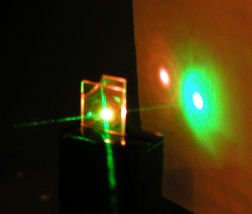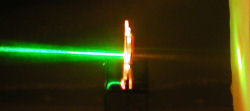Lasers were invented some 40 years ago and are now used in so many different applications.
Stable liquid crystals were discovered at about the same time, and are now the basis of a large display industry. Both technologies involve photonics, the former in the creation and use of light and the latter in the control and manipulation of light. However, it is only recently that these two mature technologies have been combined to form liquid crystal lasers, heralding a new era for these photonic materials and the potential for new applications such as:
- Medical applications. Lasers are widely used for medical procedures such as the removal of skin blemishes. However, currently different coloured lasers are used for different procedures. Each individual laser is very expensive and they can be quite large in size, approximately the size of a small fridge. The microscopic size of these liquid crystal lasers (the size of a human hair) and the ability to easily vary the laser wavelength (from ultra-violet wavelengths, through the visible spectrum to infra-red wavelengths) make these lasers an extremely attractive alternative laser. A single liquid crystal laser could be used for a range of different surgical procedures thus eliminating the need to use a different laser for each individual different procedure. Liquid crystal lasers will save time, money and space.
- Lab-on-a-chip technology. Lab-on-a-chip technology is already being exploited (Nature, 442, 27th July 2006 P351) for chemistry procedures. Through reducing the size of scientific lab components to fit onto a chip, the operating time and costs of multiple scientific experiments are also significantly reduced. The microscopic size and wide wavelength tuning range of the liquid crystal laser makes it an ideal candidate for lab-on-a-chip applications such as optical spectroscopy (studying matter by investigating light that is emitted, absorbed or scattered by it).
- Pixel arrays in liquid crystal displays (LCDs). The microscopic dimensions of a liquid crystal laser are comparable to that of an LCD pixel. This in addition to the ability to individually address and tune each laser (pixel) will enable brighter LCDs with higher contrast ratios to be developed.
Professor Harry Coles, Dr Alison Ford and Dr Stephen Morris from the Department's Centre of Molecular Materials for Photonics and Electronics present an overview of the topic of liquid crystal lasers in an article published in the July/August 2006 'Materials Today' journal http://www.materialstoday.com . The article summarises the characteristics of liquid crystals that lead to laser devices, the wide diversity of possible laser systems, and the properties of the light produced.



